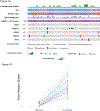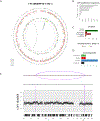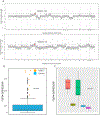Comprehensive Molecular Profiling of Desmoplastic Small Round Cell Tumor
- PMID: 33753552
- PMCID: PMC8293793
- DOI: 10.1158/1541-7786.MCR-20-0722
Comprehensive Molecular Profiling of Desmoplastic Small Round Cell Tumor
Abstract
Desmoplastic small round cell tumor (DSRCT) is characterized by the EWSR1-WT1 t(11;22) (p13:q12) translocation. Few additional putative drivers have been identified, and research has suffered from a lack of model systems. Next-generation sequencing (NGS) data from 68 matched tumor-normal samples, whole-genome sequencing data from 10 samples, transcriptomic and affymetrix array data, and a bank of DSRCT patient-derived xenograft (PDX) are presented. EWSR1-WT1 fusions were noted to be simple, balanced events. Recurrent mutations were uncommon, but were noted in TERT (3%), ARID1A (6%), HRAS (5%), and TP53 (3%), and recurrent loss of heterozygosity (LOH) at 11p, 11q, and 16q was identified in 18%, 22%, and 34% of samples, respectively. Comparison of tumor-normal matched versus unmatched analysis suggests overcalling of somatic mutations in prior publications of DSRCT NGS data. Alterations in fibroblast growth factor receptor 4 (FGFR4) were identified in 5 of 68 (7%) of tumor samples, whereas differential overexpression of FGFR4 was confirmed orthogonally using 2 platforms. PDX models harbored the pathognomic EWSR1-WT1 fusion and were highly representative of corresponding tumors. Our analyses confirm DSRCT as a genomically quiet cancer defined by the balanced translocation, t(11;22)(p13:q12), characterized by a paucity of secondary mutations but a significant number of copy number alterations. Against this genomically quiet background, recurrent activating alterations of FGFR4 stood out, and suggest that this receptor tyrosine kinase, also noted to be highly expressed in DSRCT, should be further investigated. Future studies of DSRCT biology and preclinical therapeutic strategies should benefit from the PDX models characterized in this study. IMPLICATIONS: These data describe the general quiescence of the desmoplastic small round cell tumor (DSRCT) genome, present the first available bank of DSRCT model systems, and nominate FGFR4 as a key receptor tyrosine kinase in DSRCT, based on high expression, recurrent amplification, and recurrent activating mutations.
©2021 American Association for Cancer Research.
Conflict of interest statement
Figures




References
-
- Gerald WL, Miller HK, Battifora H, et al.: Intra-abdominal desmoplastic small round-cell tumor. Report of 19 cases of a distinctive type of high-grade polyphenotypic malignancy affecting young individuals. Am J Surg Pathol 15:499–513, 1991 - PubMed
-
- Mora J, Modak S, Cheung NK, et al.: Desmoplastic small round cell tumor 20 years after its discovery. Future Oncol 11:1071–81, 2015 - PubMed
-
- Lal DR, Su WT, Wolden SL, et al.: Results of multimodal treatment for desmoplastic small round cell tumors. J Pediatr Surg 40:251–5, 2005 - PubMed
Publication types
MeSH terms
Substances
Grants and funding
LinkOut - more resources
Full Text Sources
Other Literature Sources
Research Materials
Miscellaneous

